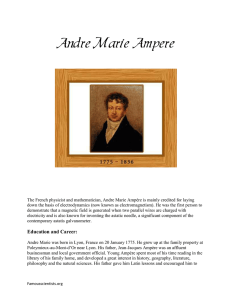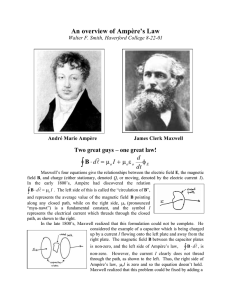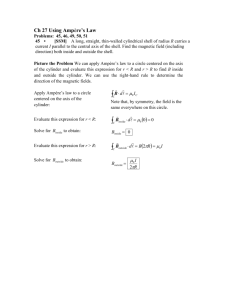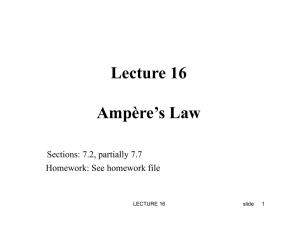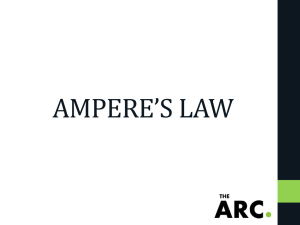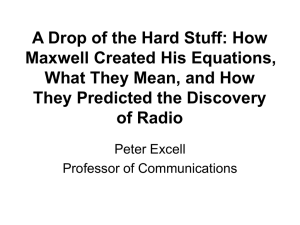Ampère`s Experiments - University of Calgary
advertisement
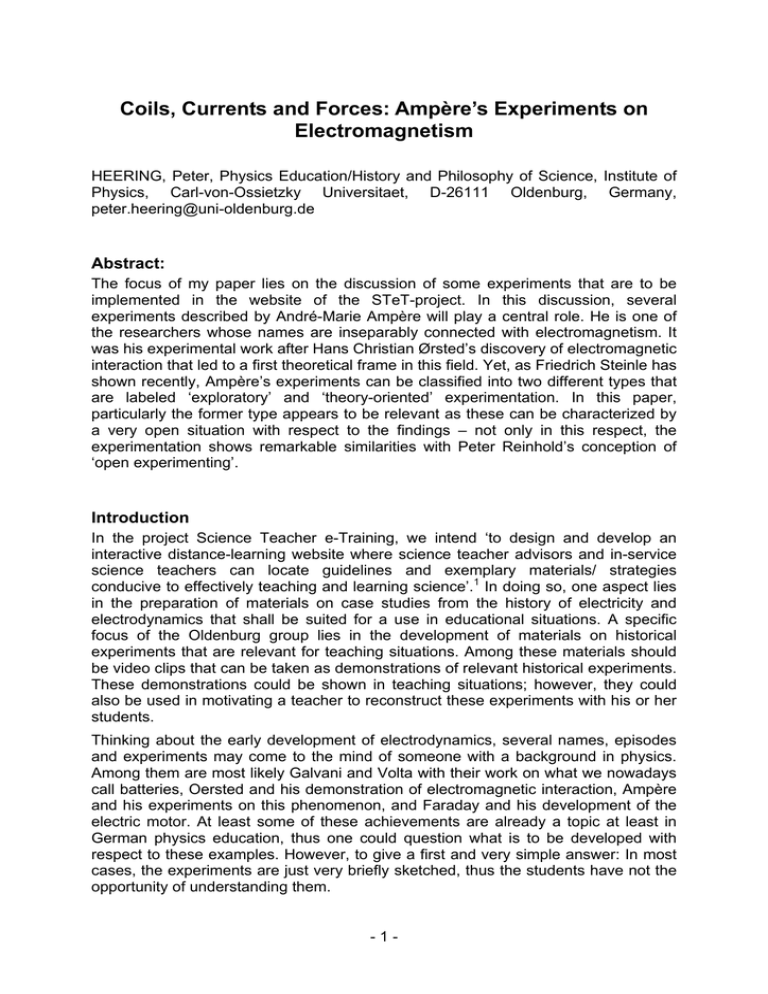
Coils, Currents and Forces: Ampère’s Experiments on Electromagnetism HEERING, Peter, Physics Education/History and Philosophy of Science, Institute of Physics, Carl-von-Ossietzky Universitaet, D-26111 Oldenburg, Germany, peter.heering@uni-oldenburg.de Abstract: The focus of my paper lies on the discussion of some experiments that are to be implemented in the website of the STeT-project. In this discussion, several experiments described by André-Marie Ampère will play a central role. He is one of the researchers whose names are inseparably connected with electromagnetism. It was his experimental work after Hans Christian Ørsted’s discovery of electromagnetic interaction that led to a first theoretical frame in this field. Yet, as Friedrich Steinle has shown recently, Ampère’s experiments can be classified into two different types that are labeled ‘exploratory’ and ‘theory-oriented’ experimentation. In this paper, particularly the former type appears to be relevant as these can be characterized by a very open situation with respect to the findings – not only in this respect, the experimentation shows remarkable similarities with Peter Reinhold’s conception of ‘open experimenting’. Introduction In the project Science Teacher e-Training, we intend ‘to design and develop an interactive distance-learning website where science teacher advisors and in-service science teachers can locate guidelines and exemplary materials/ strategies conducive to effectively teaching and learning science’.1 In doing so, one aspect lies in the preparation of materials on case studies from the history of electricity and electrodynamics that shall be suited for a use in educational situations. A specific focus of the Oldenburg group lies in the development of materials on historical experiments that are relevant for teaching situations. Among these materials should be video clips that can be taken as demonstrations of relevant historical experiments. These demonstrations could be shown in teaching situations; however, they could also be used in motivating a teacher to reconstruct these experiments with his or her students. Thinking about the early development of electrodynamics, several names, episodes and experiments may come to the mind of someone with a background in physics. Among them are most likely Galvani and Volta with their work on what we nowadays call batteries, Oersted and his demonstration of electromagnetic interaction, Ampère and his experiments on this phenomenon, and Faraday and his development of the electric motor. At least some of these achievements are already a topic at least in German physics education, thus one could question what is to be developed with respect to these examples. However, to give a first and very simple answer: In most cases, the experiments are just very briefly sketched, thus the students have not the opportunity of understanding them. -1- In my paper, I am going to discuss some of those well-known experiments; however, in doing so, I am connecting these experiments with others, not that well-known ones. In doing so, I have two intentions: On the one hand I am focusing on epistemological aspects in the educational use of these experiments. On the other hand, I am particularly interested in enabling students to develop a conceptual understanding of the physics connected with these experiments and phenomena. An additional question that is relevant for this discussion results of course from the intention that the materials are meant to be published online. Moreover, they are meant to be used (at least in the first instance) by science teachers. However, even though this aspect is of course relevant, it will not be addressed explicitly in this paper but only be considered implicitly. Yet, to show that this is a relevant problem in this context let me start with a brief sketch of one of Alessandro Volta’s electrical devices.2 Volta’s devices Volta is well known for his invention of the Voltaic pile, the first device that would nowadays be labeled as a battery. This device and the effects that it could produce became one of the major research topics for the next decades. Various researchers all over Europe worked on modifications of the pile or examined the effects it could produce. Already in his letter to Joseph Banks, President of the Royal Society of London, Volta also described a modification of his pile, the so-called ‘couronnes de tasses (a chain of cups).’3 Basically, this chain of cups can be described as a series of cups filled with salty water. These cups are connected with wires, each of which terminates at one end in a silver plate and at the other in a zinc plate. Consequently, in each cup (except the first and the final), there are a copper and a zinc plate that form a galvanic element (see Figure 1). Figure 1: Reconstruction of Volta’s chain of cups -2- To determine the intensity of electricity, Volta proposed to insert a finger in the first and another finger in one of the other cups (see Figure 2). Figure 2: Student experimenting with the ‘chain of cups’ and feeling electricity, next to the instrument a reconstructed Voltaic pile is placed. The intensity is felt and can be compared for different numbers of cups. In redoing this experiment, it becomes obvious that such an attempt to ‘meter’ electricity works surprisingly well.4 Consequently, perceiving galvanic electricity is not only a weird experience, but metering it in such a manner appears to be a plausible approach. Yet, such a ‘measurement’ is a very individual one, that means that when another students tries to meter the electricity from the chain of cups in the same manner, he or she will also be able to distinguish the impressions, however, they will differ from the ones of the first person. It is evident that such an experience cannot be communicated on a website. Consequently, in such a case the materials should simply motivate or enable the users to make their own chain of cups so that they are able to make such an experience themselves. -3- Ørsted’s experiment From this example, it should be obvious that only experiments with a visual result can be considered for the production of the videos that are to be included in the website. A simple example for this kind of experiments could be the one from Ørsted on electromagnetic interaction – all you have to have is a galvanic battery, a wire and a compass. The resultant effect – the needle moves when the circuit is closed – can easily be visualized. However, such a description has to be criticized as oversimplified: one needs a battery that is not too small and the direction of the deflection of the needle is not that obvious; consequently, the geometrical arrangement between the wire and the needle is not self-evident. Yet, even though these aspects can be adequately represented in a video, there are other aspects which make clear that such an experiment is not as straightforward as one might expect. One aspect in this respect could be the question whether Ørsted detected the effect as a result of his researches or whether this was due to pure chance. Whilst some historians claim that Ørsted had a theoretical concept that enabled him to come up with his findings, others argue that his experiment was the result of pure chance.5 However, such a controversy is not simply the result of a different interpretation of source material. Actually, these debates started already in the 19th century. A very important aspect in this respect was the connection of Ørsted towards the so-called ‘romantic physicist’, a group of researchers that related their studies to the philosophy of Schelling. These researchers, among them Ritter, Seebeck and Goethe, just to name the most prominent ones, saw themselves in opposition to the French mathematical approach that can be connected with the names of Laplace, Biot and Coulomb. During the early 19th century, romantic physicists played an important role in the German speaking community. However, by the end of the 1820ies, a younger generation of physicists started to become dominant in the community who were strong proponents of the mathematical approach and considered the romantic approach as a waste of time.6 From their perspective, it seemed absolutely plausible that a researcher like Ørsted could not have come to his findings by a systematic research that was based on theoretical considerations. Moreover, the actual geometry of the effect was unexpected – this together made it plausible to them that Ørsted had just been lucky. Ampère’s research Independent of the question how Ørsted came to his findings, the reaction towards his publication of his discovery was clear and quick. Researchers all over Europe repeated his experiment very quickly and successfully. However, at some places, the reactions still had peculiarities: Particularly in France, Ørsted’s discovery did not fit into the conceptual framework French researchers held. Thus, even though the phenomenon of electromagnetic interaction itself was not in contradiction of their conception, the actual experiment was. Yet, this difference had an important consequence for the starting point of their researches, most notably those of André Marie Ampère: This becomes very clear from Friedrich Steinle’s analysis of Ampère’s experiments.7 The first apparatus that Ampère described in a publication was the balance that demonstrated the forces between two parallel, linear conductors through which an electrical current is conducted (see figure 3). -4- X Y E F P Q C D A B Figure 3: Reconstruction of Ampère’s balance for demonstrating the forces between currents P and Q are two metallic stands who have at their upper end (X, Y) a small pot that is filled with mercury. Inserted in each pot is a pin that is connected to the conductor ECDF. E and F are connected with a glass rod; in the middle of this rod is a formable wire fixed that bears at its upper end a copper ball. This construction serves as a counterweight for the rod ECDF, it is formed in a manner that already very minute forces on the rod CD caused a deflection. Parallel to this rod is a second one AB. One current goes through the wire AB, the second one through the construction PXECDFYQ. Depending on the direction of these currents, the two conductors AB and CD would attract or repel each other. (The forces of the perpendicular parts of the circuit cancel each other out.) Even though this ‘current balance’ was the first of his electromagnetic apparatus that appeared in print and has become to some extend emblematic, it is actually not the first set-up that Ampère has used. Most of his early experiments were carried out with coils, spirals and magnets that were arranged in various manners. Ampère suspended them and closed the circuit so that currents were flowing through the conductors. He then observed whether an attraction or repulsion occurred, thus attempting to develop a theoretical concept of this phenomenon. In doing so, he could demonstrate that an interaction does not only occur between a magnet and a current but also between two currents. As Steinle showed from his analysis of Ampère’s laboratory notebooks and manuscripts, these experiments were crucial for Ampère’s development of his conceptual understanding of electromagnetic interaction. -5- Steinle calls this type of experimenting exploratory and contrasts it to theory-oriented experimentation. Yet, it would be an oversimplification to say that Ampère’s initial experimenting in the field of electrodynamics can be characterized by the lack of a theoretical framework. Even though Ampère had a theory, it appeared to be inadequate to develop a further understanding of this new phenomenon. Consequently, Ampère’s exploratory experiments can be seen as attempts to develop a conceptual understanding that would finally develop into a theory. The apparatus that Ampère finally published – the ‘current balance’ – can in some sense be seen as the result of these earlier experiments – even though I would not describe it as a materialization of the theory, it is probably more adequate characterized as a demonstration of Ampère’s arrival at a theory. From a didactical point of view, the exploratory experiments appear to me much more attractive than the theory-oriented. The latter are demonstrations of an already existing theory, thus they can be very useful in clarifying or communicating this theory, yet, it can be questioned whether these experiments can be seen as adequate to enable students to develop their own theory. In this respect, the exploratory experiments have more potential as they are not that theory dominated but much more open.8 This is an aspect that makes these experiments particularly interesting with respect to educational situations. They are still very open to modifications; in doing so, one can easily test hypotheses that result from individual conceptual considerations. It thus appears to be important to make not only the well known experiments of Ampère accessible but also the exploratory ones. But what do these experiments look like? In several of his experiments, Ampère suspended a magnet and a wire that was formed either to a spiral or to a coil and which was connected to a strong battery. In doing so, he could examine whether an attraction or repulsion could be observed between the magnet and the coil or the spiral respectively. In a second step, Ampère replaced the magnet with a second coil or a second spiral. These experiments sound fairly simple, however, they are not. From redoing these experiments it became obvious that one needs a sufficiently powerful battery and that it is crucial to use wires that are flexible enough to allow the movement of the spiral or coil. At the same time, the wires have to be inflexible enough to form a spiral or a coil.9 Yet, this is not the only difficulty that arises: It also became obvious that (even for university students) it is not simple of self-evident whether attraction or repulsion will occur. This can be seen as an indication that these experiments differ conceptually from what we nowadays teach in electrodynamics. Yet, it appears to be helpful with respect to developing a conceptual understanding of electromagnetic interaction – even though with respect to the effectiveness of the didactical application, more research is still necessary. From reconstructing the experiments, it became obvious that the interaction between the two coils was fairly weak even though the currents were very high (see Fig. 4).10 -6- Figure 4: Two coils suspended without the current (left) and with the current (right). This was different when the spirals were used, here, significantly stronger interactions could be observed. The spirals were attracted or repelled with a considerable force as soon as the circuit is closed. Figure 5: Two spirals suspended without current -7- Figure 6: Two suspended spirals repelling (left) and attracting each other (right) From the pictures, it should be clear that these experiments are very simple with respect to the set-ups and the procedures – even though the effects can be optimized. However, the experiments would most likely be particularly beneficial for educational purposes when they are actually carried out in the classroom. Consequently, the videos of these experiments are more to be seen as a motivation for teachers to rebuilt the set-ups and use them in their classrooms. This is different with the current balance: This device is no longer open to modifications, on the contrary. It serves only one purpose – to demonstrate the forces between two parallel currents. Actually, the device is not meant to be modified it is a demonstration that should show an audience the interaction of the currents. This means that the audience is kept receptive. Consequently, apart from the technical effort that would be necessary to reconstruct the balance, it is – apart from being more authentic – not very different whether the students see the apparatus or a video of the apparatus. Faraday and the electrical motor Ampère’s experiments are not the only ones Steinle discusses in terms of exploratory and theory-oriented experimentation. His second detailed example is Michael Faraday’s experiments on circular motion of the magnet which resulted in the end in what can be considered as one of the first electrical motors11. Again, Steinle identifies several experiments that are exploratory; again, Faraday ends up with a device that is meant to demonstrate that he has successfully come to a theory of the phenomenon. However, according to Steinle’s analysis, Faraday uses -8- for a longer period the strategy of exploratory experimentation than Ampère had done. What appears more important to me is another aspect in this case: Faraday’s ‘motor’ is not only the end of this development but can also be seen as a starting point of another one – the development of the electric motor. In this respect, Moritz Hermann von Jacobi is another important person as he managed to realize the first electrical motor with a practical utility: his device could a boat on the river Newa12. Thus, this complex can not only be used to develop an understanding of movements that are caused by an electromagnetic interaction. It can also be used to make the relation between physics and technology an issue in the science classroom. And in this case, the videos might play a crucial role: as it is very expensive and technically difficult to reconstruct Jacobi’s motor, its demonstration could most likely not be realized in the classroom. However, showing a video would enable the students to develop an understanding of how this motor works. Here, more research will be necessary. Notes 1 Information on this project can be found at http://www.ucy.ac.cy/~seiicase/stet/index.html. This project is financially supported by the EU Socrates programme, programme number 129552-CP-12006-1-GR-COMENIUS-C21. 2 One might expect to start the discussion with Galvani’s experiments, however, I consider it to be inappropriate for ehtical reasons to dissect frogs in order to use them as an electroscope. In this aspect, I strongly contradict Kipnis’ suggestion: ‘If possible, do these experiments in a laboratory setting’, N. Kipnis: Scientific Controversies in Teaching Science: the Case of Volta. In: F. Bevilacqua, E. Giannetto, M. Matthews (Eds.): Science Education and Culture: the Contribution of History and Philosophy of Science. Dordrecht: Kluwer, 2001, 255-271, here 268. In teaching, Galvani’s experiments should be discussed and contrasted with Volta’s work. In this context, it could be clarified that the experiments are unethical nowadays, but also that these standards change and that such experiments were completely appropriate at the end of the eighteenth century. 3 A. Volta, On the Electricity excited by the mere Contact of conducting Substances of different Kinds, in: The Philosophical Magazine 7 (1800), pp. 289-311, on p. 295 (reprinted in A. Volta, On the Electricity excited by the mere Contact of conducting Substances of different kinds: Bicentenary Edition in French, English, German and Italian of the Letter to Sir Joseph Banks of the 20th of March 1800. Milano: Ulrico Hoepli, 1999, pp. 31-53. 4 This chain of cups is used in lab courses for physics teachers at the university of Oldenburg, the experiences I am referring to were made during these courses. 5 Kipnis argues in favor of the version that Oersted’s discovery resulted from chance, see N. Kipnis, Chance in Science: The Discovery of Electromagnetism by H.C. Oersted, in: Science & Education 14, 2005, pp. 1-28. A significantly different position is held in R. De Andrade Martins, Resistance to the discovery of electromagnetism: Ørsted and the symmetry of the magnetic field, in: F. Bevilacqua & E. Giannetto (Eds.): Volta and the history of electricity. Pavia / Milano: Università degli Studi di Pavia / Editore Ulrico Hoepli, 2003, pp. 245-265. 6 The younger researchers and their understanding of scientific practice has been discussed in C. Jungnickel; R. McCormmach: Intellectual Mastery of Nature: Theoretical Physics from Ohm to Einstein, Vol. 1: The Torch of Mathematics 1800 - 1870. Chicago and London: University of Chicago Press, 1986. 7 F. Steinle, Explorative Experimente: Ampère, Faraday und die Ursprünge der Elektrodynamik. Stuttgart: Steiner, 2005. Steinle also points out that Biot attempted to implement this new effect into the French conception of central forces. 8 With the term ‘open’ I m referring to Peter Reinhold’s conception of ‘open experimentation’, see P. Reinhold, ‘Open Experimenting – An Approach to Structure Science Teaching and Learning’, S. Hopmann; K. Riquarts; I. Westbury (eds.) Teaching as a Reflective Practice. The German Didaktik Tradition, Erlbaum, Mahwah (New Jersey), 2000, 295-318. For another example of historical -9- experiments that show similarities to this ‘open experimentation’ see P. Heering, ‘Educating and Entertaining: Using Enlightenment Experiments for Teacher Training’, in: P. Heering, D. Osewold (eds.): Constructing Scientific Understanding through Contextual Teaching. Berlin: Frank & Timme, 2007, 65-81. 9 Ampère’s experiments on spirals and coils were analyzed with the replication method by J. Lühr, see J. Lühr, Die Geschichte eines Demonstrationsexperiments: Zur Geschichte der Ampère’schen Stromwaage. In P. Heering; F. Rieß; C. Sichau (Eds.): Im Labor der Physikgeschichte: Zur Untersuchung historischer Experimentalpraxis. Oldenburg: BIS, 2000, pp135-156. 10 We used a modern car battery which is most likely stronger than what was available for Ampère. 11 For a discussion of Faraday’s experiments and their reconstruction see D. Höttecke, Die Natur der Naturwissenschaften historisch verstehen: Fachdidaktische und wissenschaftshistorische Untersuchungen. Berlin: Logos, 2001. 12 On Jacobi and his motor see in particular D. Habben: Experimentelle Untersuchungen zur Umwandlung von elektrischer in mechanische Energie am Modell eines frühen Elektromotors nach Jacobi. Oldenburg: teacher thesis, 1991. A very recent historical discussion of Jacobis work is found in H.O. Sibum: Maschinen, Fledermäuse und Schriftgelehrte: Experimentalwissen im späten 18. und 19. Jahrhundert. In: H. Schramm; L. Schwarte; J. Lazardzig (Eds.): Instrumente in Kunst und Wissenschaft: Zur Architektonik kultureller Grenzen im 17. Jahrhundert. Berlin: Walter de Gruyter, 2006, pp. 302-318 - 10 -
